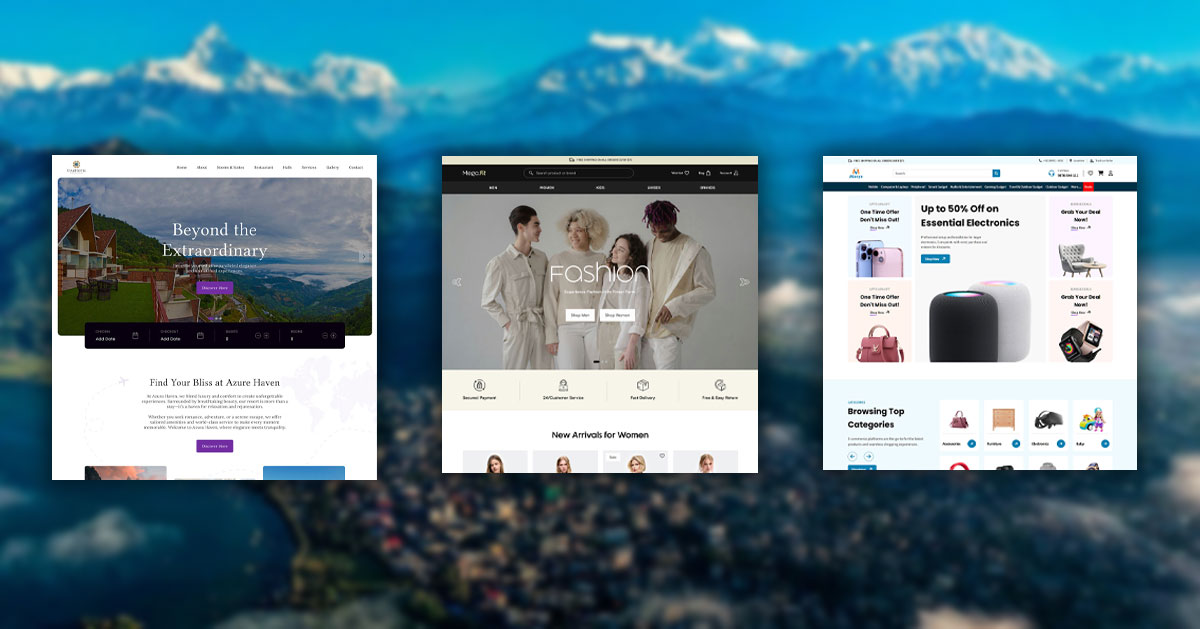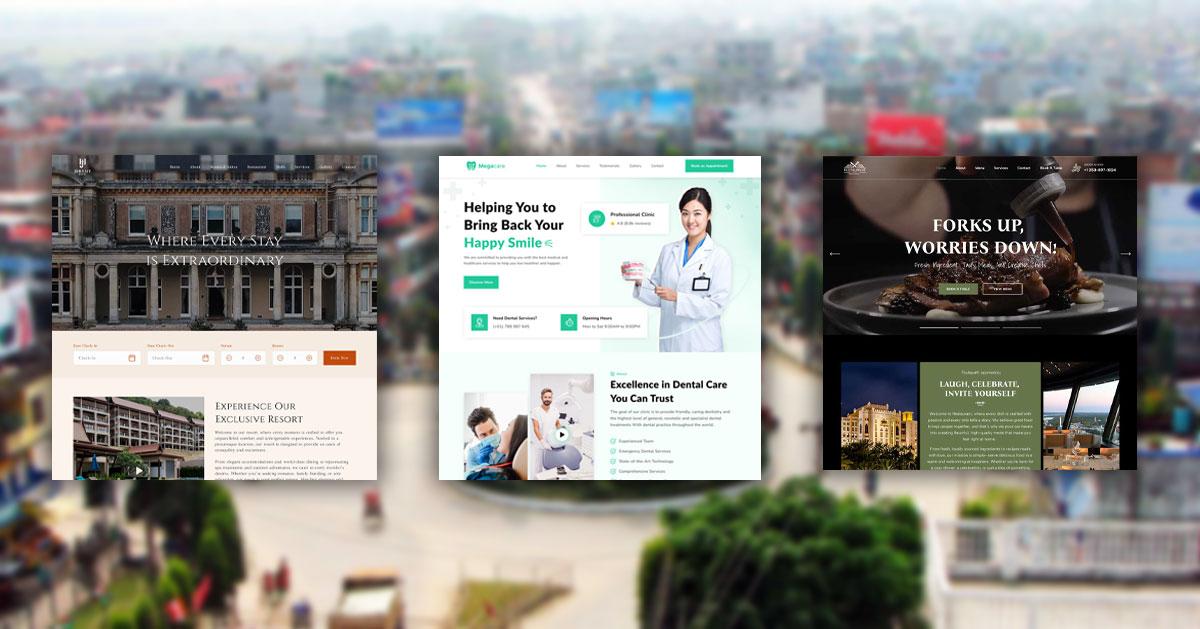Website design is ever-evolving, with new design ideas and innovations constantly appearing. To keep up with the rest of the world, it is necessary to keep track of the latest trends that are gaining popularity. Discover 2025’s top web design trends—minimalist layouts, bold hero text, interactive storytelling, AI chatbots, dark mode. Mega Web Link brings them to life.
Several noteworthy website designing trends of 2025 have captured the attention of web designers at Mega Web Link.
Minimalism, characterized by simplicity and intentional use of elements, reflects a pursuit of elegance. Animations breathe life into web pages. Bold hero text has emerged as a replacement for hero images.
Trends that contribute to immersive user experiences include Interactive storytelling, AI chatbots, parallax scrolling, and dark mode. 3D floating buttons, custom illustrations, and organic shapes also offer better experience by adding a playful touch to websites. Similarly, data visualization stands out as a powerful tool for presenting complex information in a simplified manner.
We will discuss these 2025 web design trends further in the section below.
Website Design Trends in 2025
Here are the biggest website design trends that our web designers at Mega Web Link have noticed in 2025:
Minimalist design
Minimalist design is characterized by simplicity, clarity, and intentional use of minimal elements. In recent times, websites have embraced a sleek and smooth look, often featuring lots of white spaces or negative spaces. Apple has been doing this for years, and in 2025, a lot of web designers have noticed its appeal.
Minimalism gets rid of unnecessary elements and distractions, focusing on essential components to convey a clear and straightforward message. The use of clean lines, simple typography, and a restricted color palette contribute to a neat, tidy and visually pleasing appearance.
This design prioritizes user experience by reducing visual noise, improving readability, and creating a sense of elegance. It results in a modern looking website that makes users feel calm and focused.
Scrolling animations
Scrolling animations involve the use of animated effects that occur as a user scrolls down or up a webpage. These take advantage of a user's natural scrolling behavior to trigger animated effects. As a user navigates through the content, various elements on the webpage come to life. They are used to guide the user's attention, reveal content progressively, or simply make a website more interactive.
These animations can range from simple effects like fading or sliding in elements to more complex transformations and transitions. When website elements animate into place, they provide a sense of storytelling and guides the user through the page.
Micro animations
Micro animations are small, subtle design elements that play a crucial role in enhancing user experience within digital interfaces. These animations provide immediate feedback, guide user interactions, and improve the overall perception of a website.
By offering visual cues, such as changing button appearances or using loading indicators, micro animations make websites look more polished. They create a sense of continuity by smoothing transitions between different interface states and reflect attention to detail.
Additionally, these animations help to make visitors more patient. For instance, loading animations inform users about ongoing processes, and makes their waiting time seem shorter. Overall, these small yet impactful animations contribute to a polished and enjoyable digital interaction.
Big and bold hero text
Hero images are large, visually impactful images displayed on top of a webpage. It serves as a focal point to capture the viewer's attention. However, a lot of companies have stopped using such images.
Instead, they use big and bold text to tell their motto or a slogan. This design’s purpose is to convey the main message or value proposition of the content, product, or service presented on the page.
Interactive storytelling
If you have a story to tell, don’t just write it - illustrate it. These are significantly easier to understand, and are more fun to read than a big wall of text. By incorporating relevant images and graphics, it actively engages the audience.
AI Chatbot
AI chatbots took over the world like a storm in 2024. As 2025 rolls in, the chatbot feature not only remains relevant but is becoming even more widespread. Millions of websites have started adding an AI-powered chatbot that pops up on the bottom right corner when the page is loaded.
If you want to hop on the trend, then we suggest you to be careful when finalizing your decision. Because a badly designed and programmed chatbot is annoying and it leads to a higher number of visitors leaving your website.
Chatbots are extremely useful to get user input and increase user engagement, but requires investment into good programming. It is better to have no chatbot at all rather than a bad one.
Parallax scrolling
When looking outside a car window while traveling fast, you must’ve noticed that trees and buildings next to the road pass rapidly, but distant landscapes appear to move slowly. This is called a parallax effect. Designers make use of this effect in web design also.
Parallax scrolling makes the background of a webpage move at a different speed than the foreground elements, such as text or images, while scrolling. It creates an illusion of depth and adds a dynamic, three-dimensional effect to the webpage. This has been a website design trend for a while, and it is going to remain relevant in the future as well.
Dark mode
Dark mode, or night mode, transforms the color scheme by making background colors darker while keeping text and interface elements lighter. This reduces eye strain, particularly in low-light settings such as night time or dimly lit places.
The dark mode is also appreciated for reducing eye fatigue during prolonged device use. Additionally, it is also favored for its aesthetic appeal, providing a sleek and modern look. Moreover, dark mode has the added benefit of saving battery life on devices with OLED or AMOLED screens.
However, not every website needs a dark mode. Its suitability depends on the type of content being presented. For instance, websites that rely on multimedia content, such as photography or design portfolios, may find that light mode showcases their work more effectively. Furthermore, some users may find it less readable or less visually appealing.
3d Floating buttons
Designed to stand out from the background, 3D floating buttons appear to have depth and elevation. These buttons stand out from the background through the use of shading, gradients, and shadows.
The "floating" aspect suggests that these buttons seem to hover above the surface of the webpage. Using these hover effects alongside subtle animations can make your website slightly more fun to use. By making buttons look like physical buttons, they give a confirmation that the user has performed an action successfully.
Custom illustrations
Custom illustrations are handcrafted graphical elements made specifically for a website. Unlike stock illustrations, these are created by professional graphic designers to uniquely represent a brand's identity and messaging.
Custom illustrations usually align with the brand's color palette, typography, and overall design. Their uniqueness sets a website apart, creating a distinctive user experience. In addition, custom illustrations enhance content by serving as visual aids to convey complex ideas, and adding a human touch to the digital interface.
These illustrations are versatile, adapting to different design needs such as hero sections, banners, and infographics. Ultimately, custom illustrations are powerful storytelling tools that evoke emotions to strengthen the brand-consumer connection.
Organic shapes/fluid shapes
Organic shapes, or fluid shapes, are irregular, naturally flowing shapes. Such shapes make a website look more playful, creative, and approachable. These shapes often resemble elements found in nature, such as curves, waves, and asymmetrical contours.
They are different from the more rigid and geometric shapes that are traditionally used in web design. The use of organic shapes brings a sense of fluidity. This approach is the opposite of strict grid systems and straight lines, allowing for a softer and more visually engaging presentation.
This trend embraces the idea that digital design can reflect the organic patterns found in nature that people find pleasing.
Data visualization
Data visualization involves the graphical representation of complex data through charts, graphs, and maps to uncover patterns and insights. It serves as a powerful tool for exploring datasets, identifying patterns, and communicating complex information in simplified ways.
If you have statistics that you want to show off, you can do so via data visualization. It will inform your website visitors in an interesting way and they will learn more about your brand.
Well-designed visualizations prioritize clarity and simplicity. You can choose different types of visualizations based on the nature of the data. The use of color and design principles is critical for effective data representation.
Conclusion
These trends collectively shape the digital landscape of websites in 2025. Each trend serves a specific purpose, whether it's enhancing user engagement, conveying a brand's identity, or showcasing complex information. As websites continue to evolve, these trends represent visual upgrades as well as methods of meeting growing expectations.
After going into details of each trend, it becomes clear that a fusion of design and functionality is the biggest selling point of modern website design. And that is exactly what the Mega Web Link team excels at. We implement these trends in thoughtful & user-centric approach, and if you want to partner with us, feel free to reach out. We wish you all the best!




